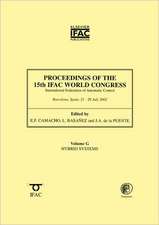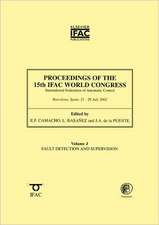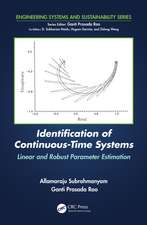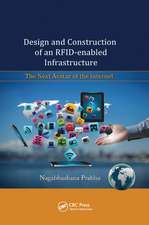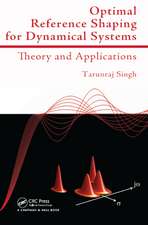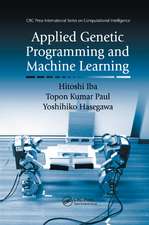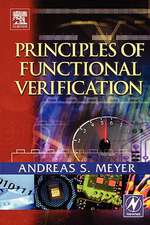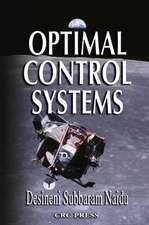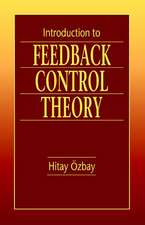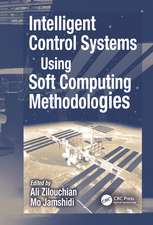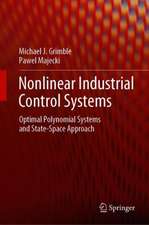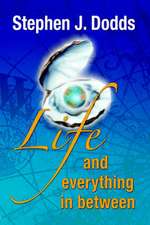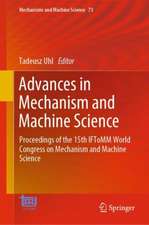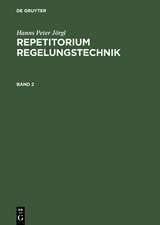Feedback Control: Linear, Nonlinear and Robust Techniques and Design with Industrial Applications: Advanced Textbooks in Control and Signal Processing
Autor Stephen J. Doddsen Limba Engleză Paperback – 3 aug 2015
Feedback Control is self-contained, paying much attention to explanations of underlying concepts, with detailed mathematical derivations being employed where necessary. Ample use is made of diagrams to aid these conceptual explanations and the subject matter is enlivened by continual use of examples and problems derived from real control applications. Readers’ learning is further enhanced by experimenting with the fully-commented MATLAB®/Simulink® simulation environment made accessible at insert URL here to produce simulations relevant to all of the topics covered in the text. A solutions manual for use by instructors adopting the book can also be downloaded from insert URL here.
Feedback Control is suitable as a main textbook for graduate and final-year undergraduate courses containing control modules; knowledge of ordinary linear differential equations, Laplace transforms, transfer functions, poles and zeros, root locus and elementary frequency response analysis, and elementary feedback control is required. It is also a useful reference source on control design methods for engineers practicing in industry and for academic control researchers.
Din seria Advanced Textbooks in Control and Signal Processing
- 17%
 Preț: 460.72 lei
Preț: 460.72 lei - 15%
 Preț: 659.35 lei
Preț: 659.35 lei -
 Preț: 375.68 lei
Preț: 375.68 lei - 15%
 Preț: 593.42 lei
Preț: 593.42 lei - 15%
 Preț: 616.31 lei
Preț: 616.31 lei - 18%
 Preț: 991.55 lei
Preț: 991.55 lei - 20%
 Preț: 572.72 lei
Preț: 572.72 lei - 15%
 Preț: 502.22 lei
Preț: 502.22 lei -
 Preț: 393.90 lei
Preț: 393.90 lei - 15%
 Preț: 499.26 lei
Preț: 499.26 lei -
 Preț: 394.29 lei
Preț: 394.29 lei - 15%
 Preț: 582.30 lei
Preț: 582.30 lei -
 Preț: 358.79 lei
Preț: 358.79 lei - 15%
 Preț: 652.49 lei
Preț: 652.49 lei -
 Preț: 396.02 lei
Preț: 396.02 lei -
 Preț: 396.40 lei
Preț: 396.40 lei - 15%
 Preț: 505.83 lei
Preț: 505.83 lei - 19%
 Preț: 564.48 lei
Preț: 564.48 lei - 20%
 Preț: 333.72 lei
Preț: 333.72 lei -
 Preț: 402.00 lei
Preț: 402.00 lei - 15%
 Preț: 502.22 lei
Preț: 502.22 lei - 15%
 Preț: 658.05 lei
Preț: 658.05 lei - 15%
 Preț: 592.95 lei
Preț: 592.95 lei -
 Preț: 392.75 lei
Preț: 392.75 lei - 19%
 Preț: 475.27 lei
Preț: 475.27 lei - 19%
 Preț: 531.49 lei
Preț: 531.49 lei - 19%
 Preț: 535.15 lei
Preț: 535.15 lei - 15%
 Preț: 711.40 lei
Preț: 711.40 lei - 15%
 Preț: 474.82 lei
Preț: 474.82 lei -
 Preț: 390.46 lei
Preț: 390.46 lei -
 Preț: 391.99 lei
Preț: 391.99 lei - 15%
 Preț: 532.05 lei
Preț: 532.05 lei - 15%
 Preț: 506.48 lei
Preț: 506.48 lei - 15%
 Preț: 597.01 lei
Preț: 597.01 lei - 21%
 Preț: 467.48 lei
Preț: 467.48 lei
Preț: 669.20 lei
Preț vechi: 869.09 lei
-23% Nou
Puncte Express: 1004
Preț estimativ în valută:
128.06€ • 136.93$ • 106.77£
128.06€ • 136.93$ • 106.77£
Carte tipărită la comandă
Livrare economică 14-19 aprilie
Preluare comenzi: 021 569.72.76
Specificații
ISBN-13: 9781447166740
ISBN-10: 1447166744
Pagini: 1012
Ilustrații: XXV, 1012 p. 674 illus., 3 illus. in color. With online files/update.
Dimensiuni: 155 x 235 x 48 mm
Greutate: 1.98 kg
Ediția:1st ed. 2015
Editura: SPRINGER LONDON
Colecția Springer
Seria Advanced Textbooks in Control and Signal Processing
Locul publicării:London, United Kingdom
ISBN-10: 1447166744
Pagini: 1012
Ilustrații: XXV, 1012 p. 674 illus., 3 illus. in color. With online files/update.
Dimensiuni: 155 x 235 x 48 mm
Greutate: 1.98 kg
Ediția:1st ed. 2015
Editura: SPRINGER LONDON
Colecția Springer
Seria Advanced Textbooks in Control and Signal Processing
Locul publicării:London, United Kingdom
Public țintă
GraduateCuprins
Plant Modelling.- Plant Model Manipulation and Analysis.- Traditional Controllers - Model Based Design.- Linear Controllers for LTI SISO Plants of Arbitrary Order - Model Based Design.- Discrete Control of Linear SISO Plants .- Model Based Control of Nonlinear and Linear Plants.- State Estimation.- Switched and Saturating Control Techniques.- Sliding Mode Control and its Relatives.- Motion Control.
Recenzii
“People with a basic background in feedback control will discover many aspects of traditional design methods not commonly considered in the literature, and those who need to tackle real-life control problems will enjoy the author's approach and the richness of the solutions studied.” (Blas M. Vinagre, Mathematical Reviews, August, 2016)
“This is the original book on feedback control of linear and nonlinear systems with some interesting applications. … This book can be recommended to undergraduate and graduate students.” (Tadeusz Kaczorek, zbMATH 1336.93002, 2016)
“This is the original book on feedback control of linear and nonlinear systems with some interesting applications. … This book can be recommended to undergraduate and graduate students.” (Tadeusz Kaczorek, zbMATH 1336.93002, 2016)
Notă biografică
My career in control engineering spans forty one years, commencing with control system design and research in the aerospace industry with Marconi Space Systems (Senior Engineer from 1973 to 1980; Principal Engineer from 1980 to 1984) followed by my appointment with the North East London Polytechnic, now the University of East London (Reader in Control Engineering from 1984 to 1994; Professor of Control Engineering from 1994 to the present time)
A milestone in my career was my responsibility for the attitude control system design for the European Space Agencies X-ray astronomy satellite, Exosat. The performance specification was stringent, demanding 1 arc second peak pointing errors about all three control axes using on-off cold gas thrusters, time optimal large angle slewing and extreme robustness against disturbance torques approaching 90% of the available control torques during orbit change thruster firing. Despite Exosat having substantially rigid body dynamics, this led me to originate non-standard nonlinear bang-off-bang state feedback control laws. The result was Europe's first spacecraft attitude control system with software implemented control laws. Following the success of this work, I instigated and carried out research programmes in Marconi Space Systems for the European Space Agency and DERA Space Department (Government research laboratory) aimed at extending my new pedigree of attitude control system to cater for spacecraft containing significant vibration modes due to flexible appendages such as long solar panels. Some of this work formed the basis of my PhD. My personal research in spacecraft attitude control has continued during my time with the University of East London, having attracted several partners in the Institute of Control Sciences of the Russian Academy of Sciences, carrying out joint research, and this led to my election as an Academician of the Academy of Nonlinear Sciences.
During my time with the University of EastLondon, my research has developed into the more general areas of a) robust control (based on sliding mode control rather than H-infinity), which seeks to achieve a specified performance of an automatic control system in the presence of plant modelling uncertainties and unknown external disturbances, and b) model based nonlinear control. Although this research encompasses two main application areas, i.e., spacecraft and electric drives, the control techniques emerging are of general application. Notable is forced dynamic control, a model based control technique, which, through nonlinear state feedback, yields a specified closed-loop performance that may or may not be nonlinear and takes external disturbances into account.
One of my contributions to linear control system design is a pair of formulae for the settling time of control systems with linear closed loop dynamics of arbitrarily high order and coincident closed loop poles, one for the 5% criterion and the other for the 2%criterion. This greatly simplifies and renders more effective the design method of pole assignment. I have found this useful for state observer design as well as the design of various controllers. I have been including the 5% formula in my lectures for several years and some of my European partners are now including it in their control systems teaching. I therefore intend to include this in my book.
It was during the continuation of the spacecraft attitude control work at UEL that sliding modes entailing rapid switching on and off of the gas-jets were found to occur under certain conditions. While this effect was undesirable regarding control valve wear and inefficiency, its potential for achieving closed loop performance independent of the dynamic parameters and external disturbances with continuous momentum exchange actuators was recognised. This also triggered research into sliding mode control for other applications, the most significant being a) an advance in the state-of-the-art vector control methods for a.c. electrical drives (produced on my EU INCO-COPERNICUS project 960169) and b) a novel motion control system for loudspeakers undertaken under a DTI Smart Award.
More recently, I originated two new robust control techniques catering for plant model order uncertainty as well as external disturbances and parametric modelling errors. One is Hyper-Sliding Mode Control, an extension of sliding mode control in which the loop closure using output derivatives beyond the usual ‘rank minus one’ limit creates additional state variables taking part in the sliding mode that may not be plant state variables. The other is ‘Observer Based Robust Control’ using my plant model mismatch equivalent input premise in which the problem of controlling an unknown plant is converted to that of controlling a known real time model of an observer by state feedback with pole assignment.
My most recent research is in the direction of reducing the carbon footprint by means of a new, relatively simple and practicable motion controller for electric drives that minimises the wastage of energy due to friction in the driven mechanism, this being predicted to save terawatts of electrical energy consumption throughout industry if employed on a large scale.
I feel that the inclusion of the aforementioned new control techniques in my book as well as the standard ones will add significant value and stimulate the reader's interest and creativity.
During my time with the University of East London I have gained considerable experience of teaching, through creating and delivering three modules in control engineering: Control System Design (final year), Control Applications (final year) for the BEng (Hons) in Electrical and Electronic Engineering and Computer Control for the MSc in Computer Systems Engineering. In addition, I have taught Control System Design and Control of Electric Drives to fourth year MSc students in Warsaw University of Technology, Poland, Wroclaw University of Technology, Poland, Silesian University of Technology, Gliwice, Poland and the University of Zilina, Slovakia. These lectures have always been very well received, students often commenting on the enhanced understanding of control and interest in the subject that they have gained. These fourth year studies are the most advanced taken on the 'continental' MSc courses, the fifth year being largely devoted to a substantial project. I have experience supervising these projects (in the field of control of electric drives) as well as control projects in the final year of the BEng (Hons) in Electrical and Electronic Engineering and the MSc in Computer Systems Engineering at the University of East London.
I have continually taken advantage of student feedback to improve my handouts, which are in the form of books. Over the years, many students have made positive comments about these handouts and my teaching style, having often encouraged me to writea book. I intend to use the chapters of these handouts as the starting point in the development of my book.
A milestone in my career was my responsibility for the attitude control system design for the European Space Agencies X-ray astronomy satellite, Exosat. The performance specification was stringent, demanding 1 arc second peak pointing errors about all three control axes using on-off cold gas thrusters, time optimal large angle slewing and extreme robustness against disturbance torques approaching 90% of the available control torques during orbit change thruster firing. Despite Exosat having substantially rigid body dynamics, this led me to originate non-standard nonlinear bang-off-bang state feedback control laws. The result was Europe's first spacecraft attitude control system with software implemented control laws. Following the success of this work, I instigated and carried out research programmes in Marconi Space Systems for the European Space Agency and DERA Space Department (Government research laboratory) aimed at extending my new pedigree of attitude control system to cater for spacecraft containing significant vibration modes due to flexible appendages such as long solar panels. Some of this work formed the basis of my PhD. My personal research in spacecraft attitude control has continued during my time with the University of East London, having attracted several partners in the Institute of Control Sciences of the Russian Academy of Sciences, carrying out joint research, and this led to my election as an Academician of the Academy of Nonlinear Sciences.
During my time with the University of EastLondon, my research has developed into the more general areas of a) robust control (based on sliding mode control rather than H-infinity), which seeks to achieve a specified performance of an automatic control system in the presence of plant modelling uncertainties and unknown external disturbances, and b) model based nonlinear control. Although this research encompasses two main application areas, i.e., spacecraft and electric drives, the control techniques emerging are of general application. Notable is forced dynamic control, a model based control technique, which, through nonlinear state feedback, yields a specified closed-loop performance that may or may not be nonlinear and takes external disturbances into account.
One of my contributions to linear control system design is a pair of formulae for the settling time of control systems with linear closed loop dynamics of arbitrarily high order and coincident closed loop poles, one for the 5% criterion and the other for the 2%criterion. This greatly simplifies and renders more effective the design method of pole assignment. I have found this useful for state observer design as well as the design of various controllers. I have been including the 5% formula in my lectures for several years and some of my European partners are now including it in their control systems teaching. I therefore intend to include this in my book.
It was during the continuation of the spacecraft attitude control work at UEL that sliding modes entailing rapid switching on and off of the gas-jets were found to occur under certain conditions. While this effect was undesirable regarding control valve wear and inefficiency, its potential for achieving closed loop performance independent of the dynamic parameters and external disturbances with continuous momentum exchange actuators was recognised. This also triggered research into sliding mode control for other applications, the most significant being a) an advance in the state-of-the-art vector control methods for a.c. electrical drives (produced on my EU INCO-COPERNICUS project 960169) and b) a novel motion control system for loudspeakers undertaken under a DTI Smart Award.
More recently, I originated two new robust control techniques catering for plant model order uncertainty as well as external disturbances and parametric modelling errors. One is Hyper-Sliding Mode Control, an extension of sliding mode control in which the loop closure using output derivatives beyond the usual ‘rank minus one’ limit creates additional state variables taking part in the sliding mode that may not be plant state variables. The other is ‘Observer Based Robust Control’ using my plant model mismatch equivalent input premise in which the problem of controlling an unknown plant is converted to that of controlling a known real time model of an observer by state feedback with pole assignment.
My most recent research is in the direction of reducing the carbon footprint by means of a new, relatively simple and practicable motion controller for electric drives that minimises the wastage of energy due to friction in the driven mechanism, this being predicted to save terawatts of electrical energy consumption throughout industry if employed on a large scale.
I feel that the inclusion of the aforementioned new control techniques in my book as well as the standard ones will add significant value and stimulate the reader's interest and creativity.
During my time with the University of East London I have gained considerable experience of teaching, through creating and delivering three modules in control engineering: Control System Design (final year), Control Applications (final year) for the BEng (Hons) in Electrical and Electronic Engineering and Computer Control for the MSc in Computer Systems Engineering. In addition, I have taught Control System Design and Control of Electric Drives to fourth year MSc students in Warsaw University of Technology, Poland, Wroclaw University of Technology, Poland, Silesian University of Technology, Gliwice, Poland and the University of Zilina, Slovakia. These lectures have always been very well received, students often commenting on the enhanced understanding of control and interest in the subject that they have gained. These fourth year studies are the most advanced taken on the 'continental' MSc courses, the fifth year being largely devoted to a substantial project. I have experience supervising these projects (in the field of control of electric drives) as well as control projects in the final year of the BEng (Hons) in Electrical and Electronic Engineering and the MSc in Computer Systems Engineering at the University of East London.
I have continually taken advantage of student feedback to improve my handouts, which are in the form of books. Over the years, many students have made positive comments about these handouts and my teaching style, having often encouraged me to writea book. I intend to use the chapters of these handouts as the starting point in the development of my book.
Textul de pe ultima copertă
This book develops the understanding and skills needed to be able to tackle original control problems. The general approach to a given control problem is to try the simplest tentative solution first and, when this is insufficient, to explain why and use a more sophisticated alternative to remedy the deficiency and achieve satisfactory performance. This pattern of working gives readers a full understanding of different controllers and teaches them to make an informed choice between traditional controllers and more advanced modern alternatives in meeting the needs of a particular plant. Attention is focused on the time domain, covering model-based linear and nonlinear forms of control together with robust control based on sliding modes and the use of state observers such as disturbance estimation.
Feedback Control is self-contained, paying much attention to explanations of underlying concepts, with detailed mathematical derivations being employed where necessary. Ample use is made of diagrams to aid these conceptual explanations and the subject matter is enlivened by continual use of examples and problems derived from real control applications. Readers’ learning is further enhanced by experimenting with the fully-commented MATLAB®/Simulink® simulation environment made accessible at http://extras.springer.com to produce simulations relevant to all of the topics covered in the text. A solutions manual for use by instructors adopting the book can also be downloaded from http://extras.springer.com
Feedback Control is suitable as a main textbook for graduate and final-year undergraduate courses containing control modules; knowledge of ordinary linear differential equations, Laplace transforms, transfer functions, poles and zeros, root locus and elementary frequency response analysis, and elementary feedback control is required. It is also a useful reference source on control design methods for engineers practicing in industry and for academic control researchers.
Feedback Control is self-contained, paying much attention to explanations of underlying concepts, with detailed mathematical derivations being employed where necessary. Ample use is made of diagrams to aid these conceptual explanations and the subject matter is enlivened by continual use of examples and problems derived from real control applications. Readers’ learning is further enhanced by experimenting with the fully-commented MATLAB®/Simulink® simulation environment made accessible at http://extras.springer.com to produce simulations relevant to all of the topics covered in the text. A solutions manual for use by instructors adopting the book can also be downloaded from http://extras.springer.com
Feedback Control is suitable as a main textbook for graduate and final-year undergraduate courses containing control modules; knowledge of ordinary linear differential equations, Laplace transforms, transfer functions, poles and zeros, root locus and elementary frequency response analysis, and elementary feedback control is required. It is also a useful reference source on control design methods for engineers practicing in industry and for academic control researchers.
Caracteristici
Allows the student to become familiar with advanced control methods from a practical standpoint Combines rigorous mathematical analysis with industrial example Instructional value enhanced by the use of MATLAB®/Simulink® simulations Includes supplementary material: sn.pub/extras

